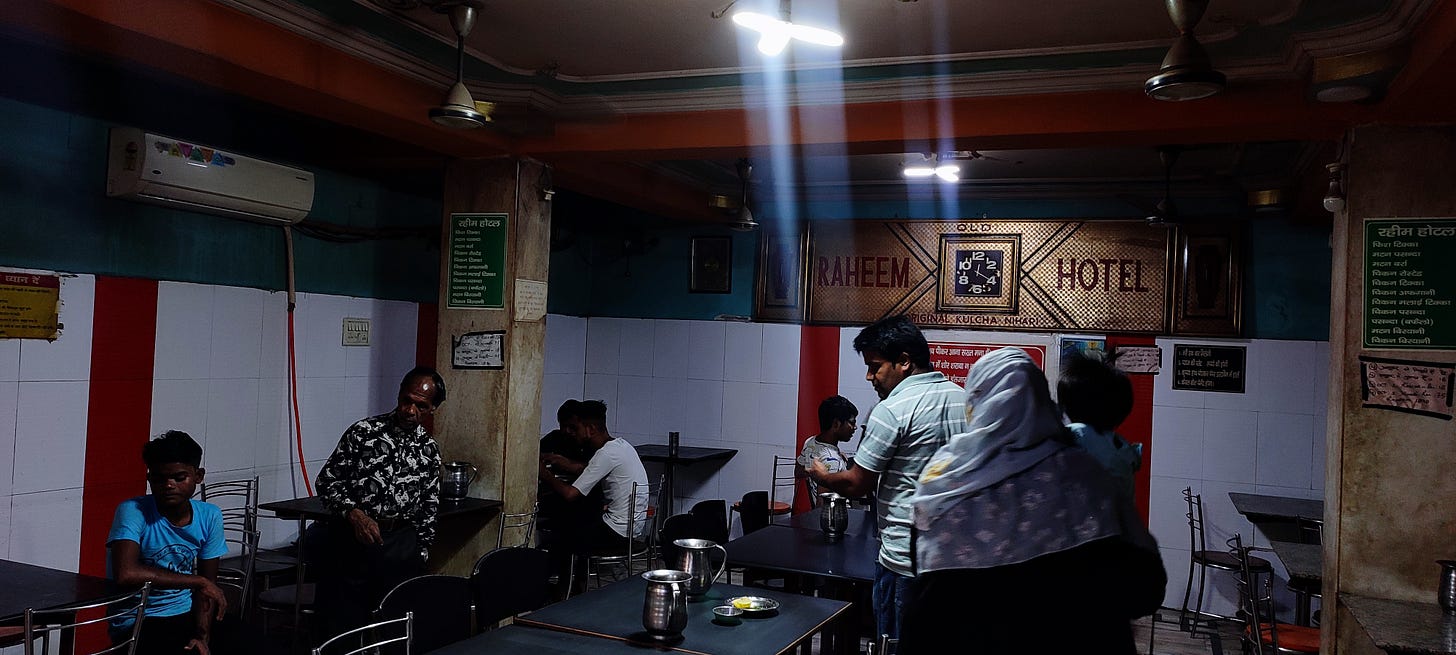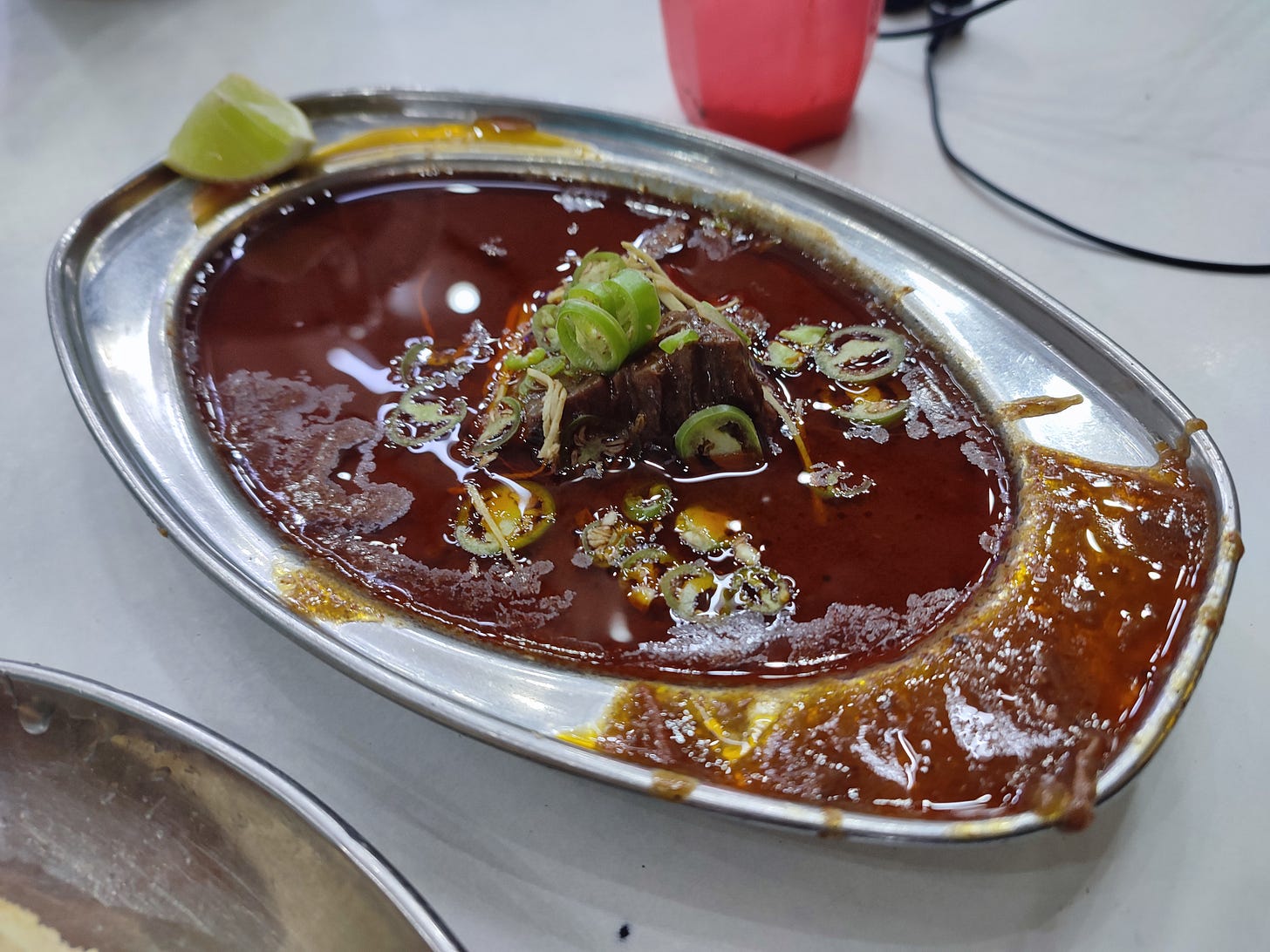Kulcha - Nihari at Raheem Hotel in Chowk, Lucknow, and is Lucknow's Food better than Delhi?
One hundred and thirty-four years ago, a man by the name of Haji Abdur Raheem started operations of an eponymous restaurant in the lanes of Lucknow’s Chowk area. This shop, known to this date as “Raheem Hotel”, continues to be operated by his descendants, serving traditional Awadhi fare such as Biryani and Kebabs using traditional cooking methods. What they are most known for is their Nihari – a traditional, slow cooked Mughlai breakfast stew that was served to members of the royal court after the dawn prayers. While a few decades ago you might have to make the trek to Chowk in the morning to sample their Nihari, owing to its increased popularity, Raheem has started serving Nihari for lunch and dinner as well.
The stew is slow-cooked over coal and wood for approximately two and a half hours, and the resultant concoction of tender meat in a velvety smooth, creamy gravy is so heavenly, it may send one to the divine realm. The gravy is not overpowered by masalas or other constituents, and it allows the flavours of the meat to seep into every corner of it. It is served with a pouring of rogan and a humble garnish of fried onions, coriander leaves and chopped green chillies, which provide some welcome heterogeneity to the dish. Nihari in Lucknow is had with Kulcha – a layered flatbread that is made of equal parts maida and ghee, that is baked in a deep, earthen oven (tandoor). This is not to be confused with the kulcha available in Delhi – the method of preparation here is much more elaborate, and the end product is a crispy, flaky, aromatic treat, one that is goes very well with the creamy Nihari gravy. I did not even need to bite into the meat after a point, the contrasting textures of the crispy, flaky Kulcha dipped into the thick, velvety, meaty gravy were enough to satisfy my taste-buds.
Debates over which city’s food is “superior” to one other aren’t uncommon on social media. Boastful Dilliwalas laughing at Mumbai’s “lack of good street food”, Kannadigas and Tamils bickering over whether the addition of jaggery in Sambar is acceptable or not, Bengalis from Calcutta defending their use of potatoes in Biryani to excited Hyderabadis, and almost everyone from India laughing at Gujarat for allegedly making Fanta-flavoured maggi its national dish. Not to come off as supercilious, but I regard almost of the answers to these questions immaterial. Food is something that is incredibly personal to all of us, and it is easy to make exaggerated claims about the quality of both one’s and one’s rival’s street food on platforms whose algorithms discourage nuanced debates or thoughtful discussion, and incentivize negative opinions, outrage and echo chambers instead.
One of these debates is the one between Delhi and Lucknow food. Lucknowis are quick to dismiss Delhi food as “lacking sophistication” in its food, praising Lucknow’s subtler palettes. Whenever Dilliwalas aren’t chest-thumping their city’s streetfood, they make sure to bemoan the lack of spice in Lucknow food, a supplementary argument to their assertions of Dilli’s primacy. As a neutral observer who only got to experience either city in his adulthood, both sides come off as rather silly. There is nothing inherently better in subtler palettes, and spicier dishes do not imply an attempt to “hide the poor quality of the meat”, as is much-repeated by lovers of Lucknow cuisine, who, quite frankly, come off as rather elitist and gatekeep-ey to me with their insistence on “sophisticated techniques” being the only correct way to cook a meal. On the contrary, the pompousness of Dilliwalas is quite detested, and somebody has to tell them that there is no minimum Scoville Scale requirement for dishes. Subtle does not equal bland, and there is much joy to be derived from food that may not immediately send a burst of flavours into your mouth.
That won’t deter readers from questioning me whether they liked Lucknow Nihari – implicit in that question isn’t whether I liked it or not, but whether I liked it more than Delhi’s Nihari. A simple yes or no answer is sure to either disappoint the querier, or elate them, depending on who is asking it. To me, Lucknow Nihari, with its subtle taste and lustful aromas, is equally good as Delhi’s version of the stew, which is has a more complex range of ingredients used which blend excellently into a spicy potion. If Delhi’s Nihari is a heavy metal song with ear-shattering guitars overlapping the complex drum rhythms and political lyrics screamed at high volumes, then Lucknow’s variant is a night at the opera, where a mesmerizing solo vocal performance is complemented by only a handful of musical instruments – no more than the majestic acoustics of the piano and the blissful hums of the violin. If one is the exhilarating thrill of riding a zippy roller coaster with its steep drops and hair-raising curves, then the other is the joy of a quiet ride in a metro as you onlook the sprawl of the city below. If one is the tense action of dodge-rolling enemies and shooting explosive barrels in the hit indie video game “Enter The Gungeon”, then the other is the serenity of mining diamonds and chopping logs in “Minecraft” for hours on end. There is no winner across any of these comparisons – it boils down to your individual desires, which are shaped by taste preferences and nostalgia. While I prefer Delhi Nihari due to having a penchant of spicier food, I do not in any way intend to say that it is better than Lucknow’s. Both are finger-licking dishes that all readers must try once in their lives, as long as they’ve kept an open mind, and are ready to experience a delicacy that deviates from their perceived norm.
Recommendations : Kulcha-Nahaari (9.5/10)
Location : Akbarigate, Lucknow, Uttar Pradesh 226003
Thanks to Himanish and Shamikh for proofreading this piece.





Amazing read, never actually got the idea of ranking things especially food here. We have so many variety, people yearn different things according to their taste and preferences so it's all about if we can appreciate the flavour that the dish seeks to provide.
This is lovely writing brother, especially those comparisons.